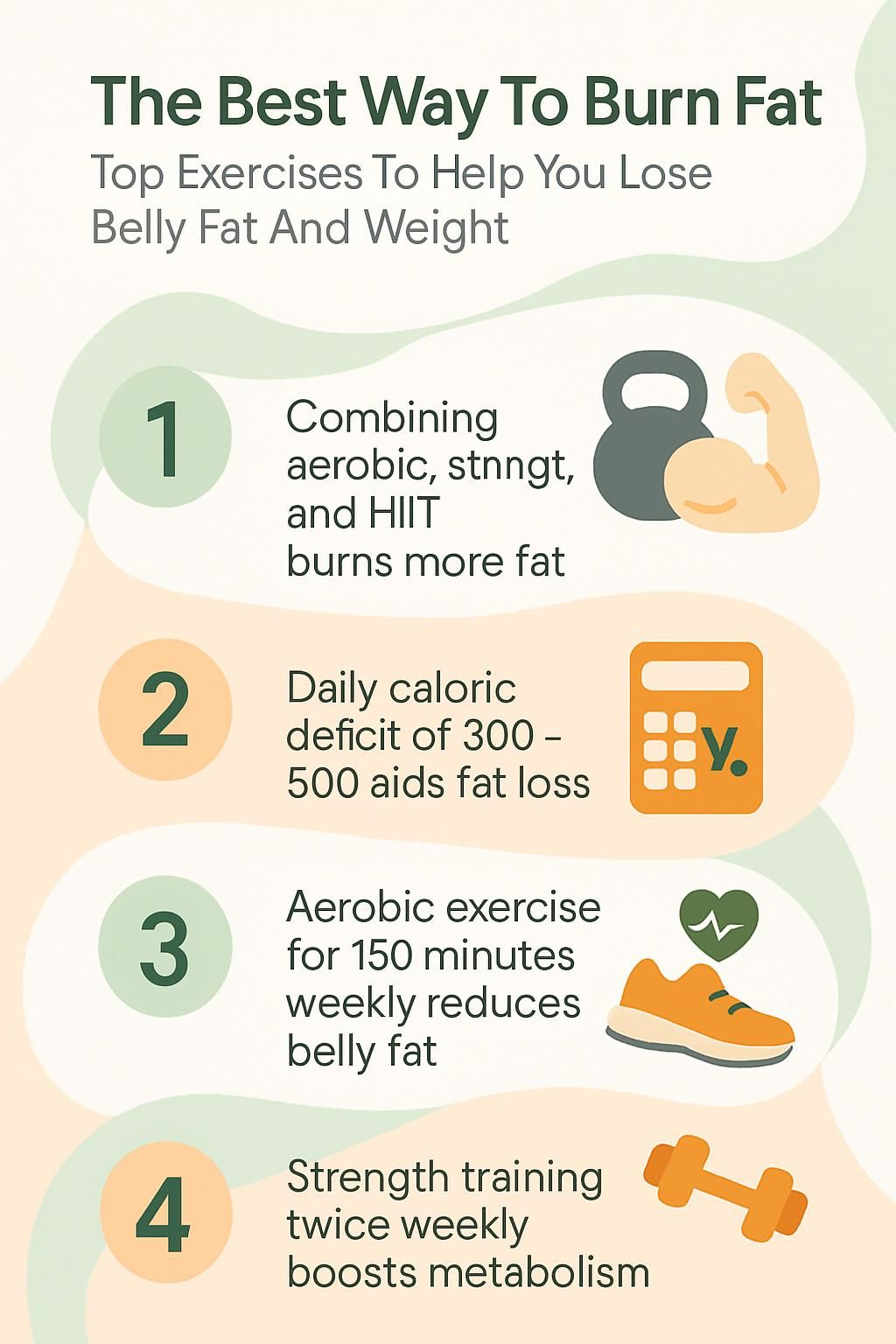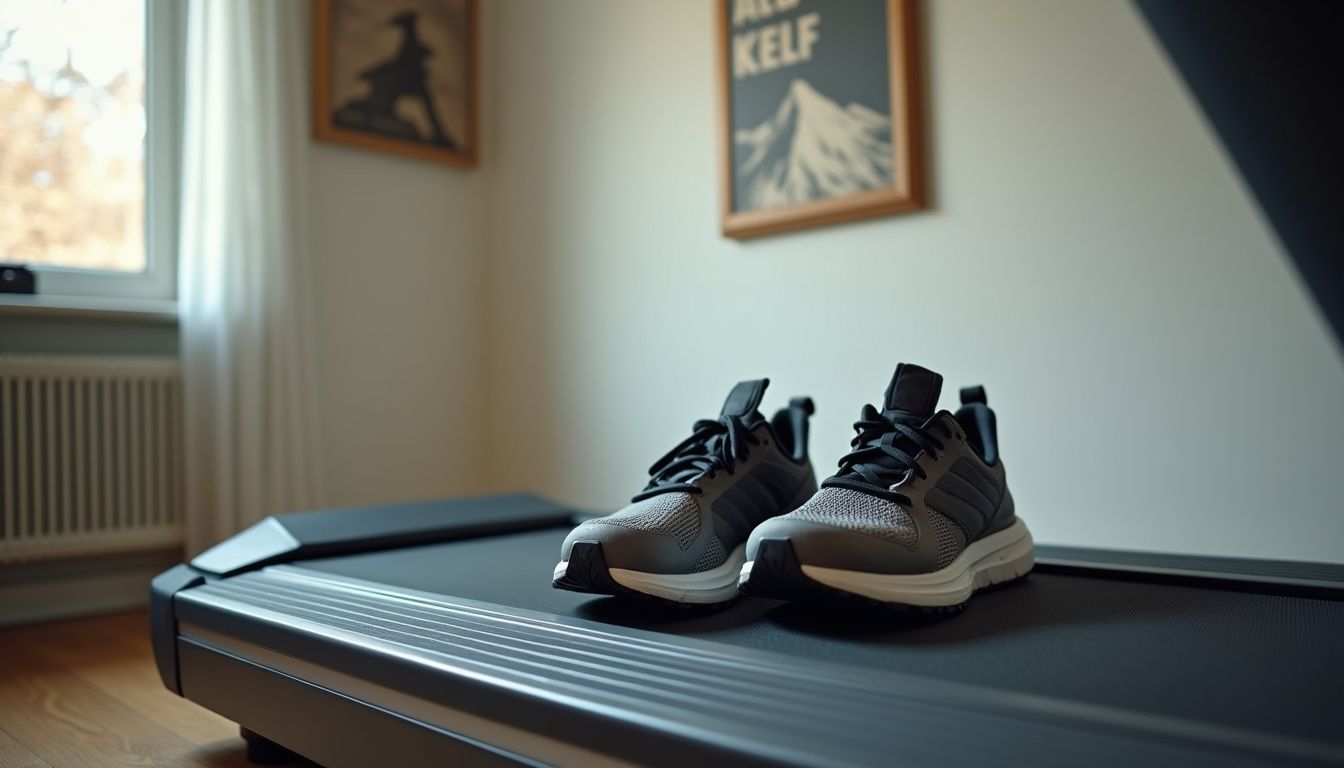The Best Way To Burn Fat: Top Exercises To Help You Lose Belly Fat And Weight
Our Nutrition Assistant AI Suite will transform your body. You will lose fat, get toned, and build muscle. Gain confidence and optimal health.
You might be fighting stubborn belly fat and looking for a clear way to lose weight. Extra fat around your waist raises the risk of heart disease, type 2 diabetes, and some cancers. This guide explains the best exercises and simple food swaps that support steady weight loss and better health. You will learn how to burn more calories, lower belly fat, and stay consistent without extreme plans.
This article is educational and does not replace medical advice. If you have health conditions, talk with your healthcare professional before starting a new exercise or diet plan.
Key Takeaways
- Combining aerobic exercise, strength training, and HIIT leads to more belly fat loss than diet or exercise alone, based on studies from 2022 to 2023.
- A daily calorie deficit of 300 to 500 supports a safe loss of about 1 to 2 pounds per week, as noted by the Mayo Clinic.
- Aim for 150 minutes of moderate cardio weekly, for example brisk walking, cycling, running, or swimming, to shrink waist size and improve health risks tied to belly fat.
- Strength training twice per week builds muscle and raises basal metabolic rate. Each new pound of muscle may burn about 6 to 10 extra calories per day.
- Limit refined carbs and sugary drinks. Eat enough protein, about 50 to 175 grams per day for many adults, plus fiber-rich foods to manage appetite and improve body composition.

Why Is Burning Fat Important for Your Health?

Burning fat supports a healthy weight and better fitness. These changes lower the risk of cardiovascular disease, type 2 diabetes, and obesity. Reducing fat, especially around the belly, also improves how your heart and blood vessels work.
What are the benefits of maintaining a healthy weight?
Keeping a healthy weight can cut disease risk. Losing as little as 5 percent of body weight lowers the chance of heart disease and type 2 diabetes, according to the Centers for Disease Control and Prevention. Your blood vessels move oxygen more efficiently, which helps blood pressure, cholesterol, and insulin sensitivity.
Many people also sleep better with regular exercise and at least 7 hours of rest. Over time, these habits reduce body fat percentage and improve daily energy. Less visceral fat, the fat that surrounds organs, supports long-term heart health.
What health risks are linked to excess belly fat?
A larger waistline raises the risk of serious problems. Visceral fat sits deep in the abdomen and surrounds organs. A waist over 35 inches for many women or over 40 inches for many men is linked with much higher risk of heart disease.
Visceral fat releases chemicals that harm blood vessels and raise blood sugar. Diets high in refined grains and added alcohol often raise belly fat. These factors can lead to metabolic syndrome, a cluster of risks that include high blood pressure, high blood sugar, and unhealthy cholesterol levels.
Groups like the American Heart Association suggest tracking waist size along with body mass index. The Mayo Clinic notes that less abdominal fat supports better metabolism and hormone balance.
Key Strategies for Burning Fat
Pair smart eating with regular exercise for steady progress. Small, daily changes help you burn more calories and keep the weight off.
How can combining diet and exercise help burn fat?
Using both diet and activity creates a stronger calorie gap. Cardio, such as brisk walking or swimming, burns energy and can lower insulin levels, which helps reduce fat storage. Strength training builds muscle, which raises your basal metabolic rate. That means you burn more calories even while resting.
Prioritize lean protein to protect muscle during weight loss. Choose whole grains and fiber-rich foods to control hunger and reduce blood sugar spikes.
- Schedule 30 to 60 minutes of moderate or vigorous activity most days.
- Lift weights or use resistance bands at least twice per week.
- Plan protein in each meal, and include vegetables, fruit, and whole grains.
Research on adults in 2022 found that regular moderate to vigorous activity helps reduce waist size. Combining diet and exercise gives you the best chance to maintain a healthy weight.
What is a sustainable caloric deficit and how do you create one?
A sustainable calorie deficit means you eat fewer calories than you burn, but not so few that you lose muscle or slow metabolism. The Mayo Clinic suggests a 300 to 500 calorie daily deficit for most people. Many will see 1 to 2 pounds of loss per week when the weekly deficit reaches about 3,500 to 7,000 calories.
- Track your intake with a food diary or app.
- Estimate your daily burn from activity and workouts.
- Fill your plate with vegetables, fruit, lean protein, and whole grains.
- Set realistic goals, such as losing 1 pound per week.
These steps support fat loss while protecting muscle and energy levels. If you have a medical condition, ask your clinician for guidance.
Best Exercises for Burning Belly Fat and Losing Weight
Different exercises help in different ways. A mix of cardio, strength work, and intervals helps you burn more calories and reduce belly fat.
Aerobic exercises
Running, brisk walking, cycling, and swimming are strong options for calorie burn. Research from 2022 shows that regular aerobic exercise reduces waist size and lowers belly fat. Aim for 150 minutes of moderate cardio or 75 minutes of vigorous cardio each week, as suggested by the Mayo Clinic Health System.
Cardio also lifts mood, improves sleep, and supports a healthy circulatory system. I started a simple running plan in college and felt more energetic within weeks while dropping about ten pounds by following these guidelines.
Strength training
Strength training builds lean muscle, which raises daily calorie burn. The Physical Activity Guidelines for Americans recommend training all major muscle groups at least two days per week. Lifting weights or doing resistance moves like squats and deadlifts can reduce total and visceral fat.
A review from 2021 that looked at 58 studies found about a 1.46 percent drop in body fat after just four weeks of resistance training. Using free weights, machines, or bodyweight supports weight loss without sacrificing muscle.
High-Intensity Interval Training (HIIT)
HIIT alternates short, hard bursts with brief rest. For example, sprint for 30 seconds, then walk for 30 seconds. A 2023 review of 36 studies found HIIT improves body composition and reduces body fat. Cycling-based HIIT showed the strongest effect in that analysis.
You can use burpees, pushups, squats, or jump rope to build a quick routine. I saw faster waist changes with cycling HIIT three times per week than with steady cardio alone.
Core-specific workouts
Planks, Russian twists, bicycle crunches, and mountain climbers make your core stronger. Plank variations build stability. Russian twists train your obliques, the side muscles of your abdomen. Mountain climbers add cardio and challenge your lower belly.
Gaining muscle may hide scale changes at first, but clothes often fit better. For best results, pair core moves with full-body strength training and a fiber-rich eating plan.
Next up: How do top aerobic exercises like running, cycling, swimming, and brisk walking help promote fat burning?
What Are the Best Aerobic Exercises for Fat Burning?
Aerobic workouts raise your heart rate and help create a calorie deficit. Pick the option you can do most consistently.
How does running and jogging help burn fat?
Running and jogging use a lot of energy. Depending on your pace and body weight, you might burn 500 to 750 calories per hour. That burn helps you keep a calorie deficit, which is key for weight loss and lower belly fat.
Running also strengthens your heart and lungs. The U.S. Department of Health and Human Services suggests at least 150 minutes of moderate cardio like brisk jogging per week. I added morning runs and noticed real belly fat changes within eight weeks, plus better daytime energy.
Is cycling effective for fat loss?
Cycling is a joint-friendly way to burn calories. A 2023 review highlights cycling-based HIIT as especially effective for fat reduction. Regular rides trim the waist and build leg muscles, which helps your metabolism even after you stop pedaling.
Add cycling several days per week to target belly fat while protecting your joints. Many people find it easier to stay consistent because cycling feels smooth and enjoyable.
Can swimming aid in burning belly fat?
Swimming works your whole body with low impact on your joints. Many people burn 400 to 700 calories per hour of moderate laps, depending on body weight and speed. Consistent sessions reduce total fat and support a healthy waist when combined with a balanced diet.
Swimming also strengthens the heart and lungs through steady breathing and water resistance. I enjoyed adding two or three 30 minute swims each week. It made staying on track easier and helped me avoid extra calorie drinks and snacks.
How does brisk walking contribute to fat loss?
Brisk walking is a practical, moderate-intensity option for most people. Regular fast walks lower waist size and support healthy blood sugar. Even 30 minutes per day can drive steady changes over time.
Walking pairs well with plant-forward or lower carb eating styles. It also limits impact on the joints, which makes it a safe choice if you need a gentle start.
How Does Strength Training Help with Fat Loss?
Strength training builds muscle and raises your resting energy use. This makes it easier to keep fat off while eating enough to feel good.
Why does building muscle boost metabolism?
Muscle tissue needs more energy than fat tissue. Each new pound of muscle can raise daily energy burn by roughly 6 to 10 calories. That sounds small, but it adds up as you build muscle across your body.
Resistance training also limits muscle loss during a calorie deficit. Your body uses extra energy to repair and maintain new muscle after workouts, which supports long-term fat loss. People who lift often burn more across the day than those who do cardio alone.
What are compound exercises like squats and deadlifts?
Compound exercises use multiple joints and large muscle groups at once. Squats train the quadriceps, hamstrings, glutes, and core. Deadlifts challenge your legs, lower back, and grip. These moves create higher calorie burn during and after training due to post exercise oxygen use, often called EPOC.
Choose weights that let you keep good form. Two to three sessions per week can speed up fat loss and lower injury risk by strengthening stabilizer muscles around major joints.
How to use resistance training for all major muscle groups?
Train your chest, back, shoulders, arms, legs, and core at least twice per week. You can use dumbbells, barbells, machines, or bodyweight.
- Push day: bench press, pushups, shoulder press, triceps work.
- Pull day: rows, pullups or pulldowns, face pulls, biceps work.
- Legs and core: squats or leg press, deadlifts or hip hinges, lunges, planks.
Increase weight or reps over time, a method called progressive overload. Building lean tissue raises your metabolism, which supports ongoing fat loss.
What Is High-Intensity Interval Training (HIIT) and How Does It Burn Fat?
HIIT works like a series of sprints and pauses. These short peaks demand more effort, then short rests let you reset for the next round.
How do you alternate intense activity with rest periods?
Pick an exercise, for example sprints or burpees. Go hard for 30 seconds, then walk or rest for 30 seconds. Repeat the cycle for 20 to 30 minutes.
These intervals keep your heart rate high and increase calorie burn in less time than steady cardio. Using a timer or fitness watch helps you hit accurate work and rest periods without guesswork.
What are examples of effective HIIT workouts?
Cycling-based HIIT: pedal all out for 30 seconds, then easy for 60 seconds. Repeat 10 to 15 times. Jogging with quick sprints works well too. At home, try 40 seconds work, 20 seconds rest, rotating through squats, mountain climbers, pushups, and jump rope.
I started with simple fast and slow sets on a stationary bike. Within two weeks, I noticed better endurance and a smaller waist.
What are the benefits of HIIT for fat burning and endurance?
Just 20 minutes of HIIT three days a week can reduce body fat and improve body composition. You burn more during the workout, and you keep burning after due to a higher oxygen demand.
HIIT also boosts fitness quickly, which helps if your schedule is tight. Many beginners find it motivating because sessions are short and varied.
Which Core-Specific Workouts Help Reduce Belly Fat?
Strong core muscles support posture, protect your back, and make other exercises safer. These moves add stability while you cut belly fat with diet and full-body training.
How to do planks and their variations?
Start face down with forearms under your shoulders. Lift your body so only forearms and toes touch the floor. Keep a straight line from head to heels. Begin with 20 to 30 seconds and build from there.
Try side planks to train your obliques. Add leg lifts to increase the challenge. I saw better midsection control after two months of every other day planks compared with crunches alone.
What are Russian twists and how do they help?
Sit, lean back slightly, lift your feet, and twist your torso side to side while holding a weight. This targets your obliques and improves rotational strength. Strong obliques support balance and posture during daily tasks and sports.
How effective are bicycle crunches?
Bicycle crunches activate both your rectus abdominis, the six pack muscle, and your obliques. Keep your neck relaxed and bring your elbow toward the opposite knee with control. Studies show bicycle crunches are among the most effective ab moves for muscle activation.
Adding this exercise made my midsection feel firmer, especially when used with other core moves and a steady walking routine.
What are mountain climbers and their benefits?
Start in a plank. Drive one knee toward your chest, then switch legs quickly. Mountain climbers raise your heart rate and work your core, shoulders, arms, and legs at once.
Short 30 second bursts increased my calorie burn during quick home workouts. This move is efficient and requires no equipment.
How Can Diet Support Fat Loss?
Food choices shape your appetite, energy, and recovery. Focus on protein, fiber, and healthy fats, and limit added sugar and refined grains.
Which high-protein foods boost metabolism?
Protein helps you feel full and protects muscle. Good choices include chicken breast, turkey, eggs, Greek yogurt, cottage cheese, fish like salmon or tuna, and plant sources like lentils, beans, chickpeas, and tofu.
Getting 10 to 35 percent of daily calories from protein, often 50 to 175 grams for a 2,000 calorie diet, supports muscle repair and a higher daily burn.
How do fiber-rich foods control appetite?
Fiber absorbs water and adds bulk, so you feel full longer. Fruits, vegetables, legumes, whole grains, nuts, and seeds are top sources. Soluble fiber forms a gel that slows digestion and helps control blood sugar.
A 2020 review found higher soluble fiber intake linked with less body weight and smaller waist size. Aim for about 28 grams daily for women and 34 grams for men. Adding oats or chia seeds to breakfast helped me avoid midmorning snacks.
Why are healthy fats important for long-term energy?
Unsaturated fats in olive oil, fish, nuts, and avocados provide steady energy and support hormones. A 2023 review found Mediterranean style eating led to greater long-term weight loss and lower BMI than low fat diets.
People with high cholesterol who ate more unsaturated fats also showed better body composition in 2022 data. I felt more stable energy after adding avocado or nut butter to breakfast.
What refined carbs and sugary drinks should you avoid?
Refined grains can spike blood sugar and increase belly fat over time. Limit pastries, white bread, and many boxed cereals. Skip sugar-sweetened drinks like soda, sports drinks, sweet tea, and flavored coffee drinks. A 2023 review of 85 studies linked these drinks to weight gain.
Choose water, sparkling water, or unsweetened tea to reduce extra calories and help manage hunger.
What Lifestyle Changes Support Fat Loss?
Daily habits add up. Sleep, stress control, water intake, and extra movement all support fat loss and weight maintenance.
How does getting adequate sleep aid fat loss?
Short sleep disrupts hunger hormones and raises cravings. Getting less than 6 hours often increases visceral fat. A 2023 review tied short sleep to higher belly fat levels.
Aim for at least 7 hours per night, as the CDC recommends. I make better food choices and avoid late snacks after a good night’s rest.
How to manage stress to reduce cortisol levels?
Chronic stress can raise cortisol, a hormone that may drive appetite and fat storage. Try 10 minutes of mindfulness, a daily walk, or deep breathing to lower tension. Support from friends or a counselor can also improve coping skills.
Reducing stress supports your metabolism and makes it easier to stick with healthy habits.
Why is staying hydrated important for metabolism?
Water helps your body process fat and control appetite. Replacing sugary drinks with water can cut calories and reduce snacking. Keep a refillable bottle nearby, and add citrus or mint for flavor without sugar.
Hydration helps metabolic processes work well during both exercise and rest.
How to increase daily movement beyond workouts?
Small changes raise your daily burn. Take the stairs, park farther away, and stand during phone calls. Walk for five minutes every hour if you sit a lot.
These steps increase non-exercise activity, which can meaningfully boost energy use over weeks and months.
What Should You Avoid During Your Fat Loss Journey?
Smart choices help you stay on track. Avoid extremes that slow your metabolism or harm your health.
Why avoid crash diets and quick fixes?
Very low calorie plans often cause fast water and muscle loss. Metabolism can drop, which makes regain more likely after the diet ends. I once tried a strict cleanse and felt weak. The lost weight came back within days along with extra pounds.
Steady habits, such as balanced meals and regular exercise, keep muscle and support long-term fat loss.
What are the risks of over-relying on weight loss supplements?
Many supplements promise rapid fat loss without strong evidence. Some raise heart rate or blood pressure, and others upset your stomach or interact with medicines. They can also distract you from proven habits like exercise and smart eating.
Focus on evidence-based steps. If you are considering a supplement, ask your healthcare professional first.
How to set realistic expectations?
Aim for 1 to 2 pounds per week. The CDC notes that slower, steady loss is easier to maintain. Progress is not linear. Some weeks the scale will stall or rise slightly.
Stick to your plan and measure more than weight. Small wins build momentum.
How Can You Stay Consistent with Your Fat Loss Plan?
Consistency comes from simple routines, clear goals, and feedback that shows your effort is working.
How to set achievable goals?
Set action goals, not just number goals. Choose to walk daily or lift twice a week instead of only aiming to lose 10 pounds. A daily burn of 500 to 750 calories more than you eat often leads to steady loss.
Use journals or apps if you like structure and privacy. Adjust as needed and keep going.
What are ways to track progress beyond the scale?
Notice how your clothes fit. Track waist size, aiming for under 35 inches for many women and under 40 inches for many men. Take monthly photos and record fitness milestones, such as longer runs or heavier lifts.
These measures reveal fat loss and strength gains that a scale can miss.
How to find enjoyable activities to stay motivated?
Pick workouts you enjoy, such as dance cardio with music or a group class. Train with a friend for accountability. In one study from 2016, social support raised exercise consistency by up to 78 percent.
I kept a sticky note on the fridge as a daily cue for walks. Try different activities until one feels fun, whether cycling at sunrise or swimming after work.
Conclusion
Active living and smart nutrition drive healthy weight loss. Cardio, strength training, HIIT, and focused core work help you burn calories and reduce belly fat. Protein keeps you satisfied, and fiber curbs appetite. Sleep, stress control, water, and extra daily movement make your plan easier to follow.
Track more than the scale. Looser clothes and a smaller waist show progress first. With steady practice, you will build a stronger body, improve energy, and lower health risks tied to excess fat. If you need help personalizing your plan, check in with a qualified health professional.
FAQs
1. What are the best exercises to burn fat and lose belly weight?
Aerobic activities such as brisk walking, cycling, and swimming help burn calories and reduce body fat. Strength training with weights or resistance bands builds muscle mass, which increases metabolism. High-intensity interval workouts alternate short bursts of intense movement with rest periods; this method is effective for burning abdominal fat according to research from Harvard Medical School.
2. How often should I exercise to see results in losing belly fat?
Experts recommend at least 150 minutes per week of moderate aerobic activity or 75 minutes per week of vigorous aerobic activity for noticeable changes in body composition. Combining three days a week of strength training with regular cardio sessions supports both weight loss and muscle gain.
3. Can diet alone help me lose belly fat without exercise?
Reducing calorie intake can lead to overall weight loss; however, combining healthy eating habits with physical activity leads to greater reductions in visceral adipose tissue around the abdomen according to studies published by the National Institutes of Health.
4. What role does personal experience play in choosing an exercise routine for burning fat?
Personal preference influences consistency and motivation when following a workout plan. For example, after trying several routines, I found that alternating between running outdoors and using resistance bands kept my interest high while supporting steady progress toward my fitness goals.
Summary: Aerobic activities, strength training, and high-intensity intervals rank among top choices for reducing excess body mass around the waistline. Consistent effort paired with mindful nutrition yields optimal outcomes based on scientific evidence as well as individual experiences.







